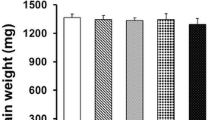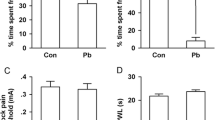Abstract
In order to assess neurobehavioral deficit subsequent to early low-level lead-exposure, Wistar-rats were prenatally Pb-exposed via their mothers, neonatally via their dams' milk, and later on via their diet containing lead acetate (745 mg Pb/kg diet). Blood-lead levels (PbB) of dams increased from 24.2–31.2 μg-% during pregnancy and suckling-periods, those of offsprings were 26.6 μg-% at about 16 days of age and 28.5 μg-% at about 190 days of age. Between 100 and 200 days of age 40 male offsprings were subjected to behavioral testing, namely an open field-test and a visual discrimination-learning task. Two learning-tasks of different complexity, i.e. orientation-and size-discrimination, were used. Data of 20 lead-treated animals were compared with those of 20 age-matched controls.
In the open-field test lead-fed animals were significantly more restless than controls; an increase of ambulation, rearing and grooming was observed. In the difficult learning-task, i.e. size discrimination, only the controls did learn the problem, whereas only one of the lead-group did; there was, however, no difference between lead-and control-animals for the easy task, i.e. orientation-discrimination. The observed effects, namely overreaction in the open field and a deficit of visual discrimination learning, may be interpreted in terms of lead-induced CNS-dysfunction. They clearly suggest that the “no-response level” for neurobehavioral damage in the rat, subsequent to early lead-exposure, must be assumed to be lower than 35 μg/100ml.
Zusammenfassung
Zur Erfassung neuropsychologischer Störungen nach ontogenetisch früher Bleiexposition wurde bei männlichen Wistar-Ratten pränatal über deren Mütter, neonatal über die Muttermilch und postnatal über Bleiazetathaltiges Futter (745 mg Pb/kg Futter) chronisch ein erhöhter Blutbleispiegel (PbB) eingestellt. In der Trächtigkeits-und Säugezeit stieg der PbB-Spiegel der Mütter von 24.2 auf 31.2 μg-% an, während derjenige der Nachkommen im Alter von ca. 16 Tagen 26.6 μg-% und im Alter von ca. 190 Tagen 28.5 μg-% betrug. PbB altersgleicher Kontrollen war stets < 6 μg-%. Im Alter zwischen 100 und 200 Tagen wurden 20 Bleitiere und 20 Kontrollen blind verschiedenen Verhaltensprüfungen unterzogen, und zwar einem Open Field-Test und einer visuellen Unterscheidungs-Lernaufgabe. Zwei Lernprobleme unterschiedlicher Schwierigkeit, Richtungs- und Größenunterscheidung, wurden benutzt.
Im Open Field-Test waren die Bleitiere im Vergleich mit den Kontrollen signifikant unruhiger: Lokomotorische Aktivität, Aufrichten und Putzverhalten waren gesteigert. Die schwierige Größenunterscheidung erlernten nur die Kontrollen, während das leichte Problem, nämlich die Richtungsunterscheidung, von Kontroll- und Bleitieren gleich schnell erlernt wurde. Die beobachteten Bleiwirkungen, gesteigerte motorische Unruhe und Lernleistungshemmung, lassen sich als Indikatoren einer funktionellen Hirnschädigung deuten. Sie legen den Schluß nahe, daß die „Wirkschwelle” für neuropsychologische Störungen nach ontogenetisch frühzeitiger Bleieinwirkung bei der Ratte als unterhalb 35 μg/100 ml liegend angenommen werden muß.
Similar content being viewed by others
References
Beattie, A. D., Moore, M. R., Goldberg, A., Finlayson, J. J. W., Mackie, E. M., Graham, J. F., Main, J. C., McLaren, D. A., Murdoch, R. M., Stewart, G. T.: Role of chronic low-level lead exposure in the aetiology of mental retardation. Lancet 1975 I, 589–592
Broadhurst, P. L.: Application of biometrical genetics to the inheritance of behavior. In: Experiments in personality, Vol. 1 (H. J. Eysenck, Ed.). London: Routledge and Kegan Paul 1960
Brown, D. R.: Neonatal lead exposure in the rat: Decreased learning as a function of age and blood lead concentration. Toxicol. appl. Pharmacol. 32, 628–637 (1975)
Brown, S., Dragann, N., Vogel, W. H.: Effects of lead acetate on learning and memory in rats. Arch. environm. Hlth 22, 370–372 (1971)
Bruaux, P.: Métabolisme du plomb chez les animaux. —Possibilités des résultats pour l'homme. In: Die gesundheitlichen Aspekte der Umweltverschmutzung durch Blei. Tagungsberichte Internationales Symposium, Amsterdam (Nederland), October 2–6, 1972, pp. 271–286. Luxembourg: CID 1973
Bullock, J. D., Wey, R. J., Zaia, J. A., Zarembok, I, Schroeder, H. A.: Effect of tetraethyllead on learning and memory in the rat. Arch. environm. Hlth 13, 21–22 (1966)
Carson, T. L., Van Gelder, G. A., Karas, G. C., Buck, W. B.: Slowed learning in lambs prenatally exposed to lead. Arch. environm. Hlth 29, 154–156 (1974)
David, O., Clark, J., Voeller, K.: Lead and hyperactivity. Lancet 1972 II, 900–903
Estes, W. K.: The statistical approach to learning theory. In: Psychology: A study of a science (S. Koch, Ed.), Vol. 2. New York: McGraw-Hill 1959
Gage, P., Litchfield, L.: The migration of lead from polymers in the rat gastrointestinal tract. Food Cosmet. Toxicol. 6, 329–338 (1968)
Golter, M., Michaelson, I. A.: Growth, behavior, and brain catecholamines in lead-exposed neonatal rats: A reappraisal. Science 187, 359–361 (1975)
Grant, L. D., Howard, J. L., Alexander, S., Krigman, M. R.: Low level lead exposures: Behavioral effects. Environ. Health Perspect. 10, 267 (1975)
Greenhouse, S. W., Geisser, S.: On methods in the analysis of profile data. Psychometrica 24, 95–112 (1959)
Haas, Th., Wieck, A. G., Schaller, K. H., Mache, K., Valentin, H.: Die usuelle Bleibelastung bei Neugeborenen und ihren Müttern. Zbl. Bakt. I. Abt. Orig. B 155, 341–349 (1972)
Hilderbrand, D. C., Der, R., Griffin, W. T., Fahim, M. S.: Effect of lead acetate on reproduction. Amer. J. Obstet. Gynec. 115, 1058–1065 (1973)
Hursch, J. B., Suomela, J.: Absorption of 212Pb from the gastrointestinal tract of men. Acta radiol. (Stockholm) 7, 108–120 (1967)
Janke, W.: Psychophysiologische Grundlagen des Verhaltens. In: Medizinische Psychologie (M. v. Kerekjarto, Ed.), pp. 1–101. Berlin-Heidelberg-New York: Springer 1976
Landrigan, P. J., Whitworth, R. H., Baloh, R. W., Staehling, N. W., Barthel, W. F., Rosenblum, B. F.: Neuropsychological dysfunction in children with chronic low-level lead absorption. Lancet 1975 I, 708–712
Lansdown, R. G., Shepherd, J., Clayton, B. E., Delves, H. T., Graham, P. J., Turner, W. C.: Blood-lead-levels, behavior, and intelligence. A population study. Lancet 1974 I, 538–541
Maker, H. S., Lehrer, G. M., Silides, D. M.: The effect of lead on mouse brain development. Environ. Res. 10, 76–91 (1975)
McNeil, J. L., Ptasnik, J. A.: Evaluation of longterm effects of elevated blood lead concentrations in asymptomatic children. Paper presented at the “Symposium on Recent Advances in the Assessment of the Health Effects of Pollution” Paris, June 26, 1974
Modak, A. T., Weintraub, S. T., Stavinoha, W. B.: Effect of chronic ingestion of lead on the central cholinergic system in rat brain regions. Toxicol. appl. Pharmacol. 34, 340–347 (1975)
Pott, F., Schlipköter, H.-W.: Die Bleibelastung des Menschen. In: Lufthygiene und Silikoseforschung 1975 (Ges. z. Förderung der Lufthygiene u. Silikoseforschung e. V., Ed.), pp. 31–58. Essen: Girardet 1976
Rabinowitz, M., Wetherhill, G., Kopple, J.: Lead metabolism in the normal human: Stable isotope studies. Science 182, 725 (1973)
Schroeder, H. A., Mitchener, M.: Toxic effects of trace elements on the reproduction of mice and rats. Arch. environm. Hlth 23, 102–106 (1971)
Seitz, P. F. D.: The effect of infantile experience upon adult behavior in animals. I. Effects of litter size during infancy upon adult behavior in the rat. Amer. J. Psychiat. 110, 916–927 (1954)
Silbergeld, E. K., Goldberg, A. M.: A lead-induced behavioral disorder. Life Sci. 13, 1275–1283 (1973)
Silbergeld, E. K., Goldberg, A. M.: Lead-induced behavioral dysfunction. An animal model of hyperactivity. Exp. Neurol. 42, 146–157 (1974)
Snowdon, C. T.: Learning deficits in lead-injected rats. Pharmacol., Biochem., Behavior 1, 599–603 (1973)
Sobotka, T. J., Cook, M. P.: Postnatal lead acetate exposure in rats: Possible relationship to minimal brain dysfunction. Amer. J. ment. Defic. 79, 5–9 (1974)
Sobotka, T. J., Brodie, R. E., Cook, M. P.: Psychophysiologic effects of early lead exposure. Toxicology 5, 175–191 (1975)
Sutherland, N. S., McIntosh, N. J.: Mechanisms of animal discrimination learning. London: Academic Press 1971
Überla, K.: Faktorenanalyse, Berlin-Heidelberg-New York: Springer 1968
Winer, B. J.: Statistical principles in experimental design. New York-San Francisco-Toronto-London: McGraw-Hill 1962
Winneke, G., Brockhaus, A., Fodor, G. G., Grieser, N.: Neurobehavioral and systemic effects of longterm blood-lead elevation in rats. II: Visual evoked potentials (in preparation)
Zielhuis, R. L.: Dose-response relationships for inorganic lead. II. Subjective and functional responsescronic sequelae — no response-levels. Int. Arch. Occup. Hlth 35, 19–35 (1975)
Author information
Authors and Affiliations
Additional information
This work was partially supported by “Bundesministerium des Innern (Bonn, Federal Republic of Germany)” and “Commission of the European Communities (Brussels, Belgium)”
Rights and permissions
About this article
Cite this article
Winneke, G., Brockhaus, A. & Baltissen, R. Neurobehavioral and systemic effects of longterm blood lead-elevation in rats. Arch. Toxicol. 37, 247–263 (1977). https://doi.org/10.1007/BF00330817
Received:
Issue Date:
DOI: https://doi.org/10.1007/BF00330817




